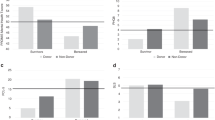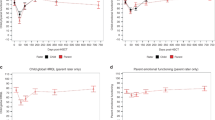Abstract
The purpose of this study was two-fold: to describe the quality of life and behavioral adjustment of survivors of pediatric bone marrow transplantation (BMT) prior to and 6 months post-BMT; and, to identify correlates of survivors’ quality of life and behavioral adjustment. Participants were 26 children and adolescents who underwent BMT, and their mothers. At pre- and 6 months post BMT, mothers completed standardized measures of their children's behavioral adjustment, quality of life, and adaptive functioning. Self-report questionnaires were completed to determine levels of maternal anxiety and depression, and family functioning. Information was also gathered about demographic variables, medical history, and symptom severity. Children's overall quality of life improved 6 months post BMT and was most strongly associated with pre-BMT levels of family cohesion. Children's behavioral adjustment remained within the normal range across time and was associated with pre-BMT levels of family cohesion and child adaptive functioning. Mothers’ psychological adjustment improved over time and was associated with quality of life, but unrelated to children's behavioral adjustment. Pre-BMT levels of family cohesion and child adaptive functioning appear to be important in understanding quality of life and behavioral adjustment of pediatric BMT survivors. Bone Marrow Transplantation (2000) 26, 427–435.
This is a preview of subscription content, access via your institution
Access options
Subscribe to this journal
Receive 12 print issues and online access
$259.00 per year
only $21.58 per issue
Buy this article
- Purchase on Springer Link
- Instant access to full article PDF
Prices may be subject to local taxes which are calculated during checkout
Similar content being viewed by others
References
Ferrell B, Grant M, Whedon M . Quality of life in bone marrow transplant. In: Spilker B (ed) Quality of Life and Pharmaco-Economics in Clinical Trials, 2nd edn Lippincott-Raven: Philadelphia 1996 1015–1028
Ferrell B, Grant M, Schmidt GM . The meaning of quality of life for bone marrow transplant survivors. Part 2. Improving quality of life for bone marrow transplant survivors Cancer Nurs 1992 15: 247–253
Atkins DM, Patenaude AF . Psychosocial preparation and follow-up for pediatric bone marrow transplantation patients Am J Orthopsychiatry 1987 57: 246–252
Phipps S, Hinds P, Channell S, Bell G . Measurement of behavioral affective and somatic responses to pediatric bone marrow transplantation: development of the BASES scale J Pediatr Oncol Nurs 1994 11: 109–117
Pot-Mees CC, Zeitlin H . Psychosocial consequences of bone marrow transplantation in children: a preliminary communication J Psychosoc Oncol 1987 5: 73–81
Lee ML, Cohen SE, Stuber ML, Nader K . Parent–child interactions with pediatric bone marrow transplant patients J Psychosoc Oncol 1994 12: 43–60
Pot-Mees CC . Psychosocial interventions in a bone marrow transplantation programme. In: Last BF, van Veldhuizen AM (eds) Developments in Pediatric Psychosocial Oncology Swets & Zeitlinger: Amsterdam 1992 93–99
Sormanti M, Dungan S, Rieker PP . Pediatric bone marrow transplantation: psychological issues for parents after a child's hospitalization J Psychosoc Oncol 1994 12: 23–42
Stuber ML, Nader K, Yasuda P et al. Stress responses after pediatric bone marrow transplantation: preliminary results of a prospective longitudinal study J Am Acad Child Adolesc Psychiat 1991 30: 952–957
Phipps S, Mulhern R . Family cohesion and expressiveness promote resilience to the stress of pediatric bone marrow transplant: a preliminary report J Dev Behav Pediatr 1995 16: 257–263
Vanatta K, Zeller M, Noll RB, Koontz K . Social functioning of children surviving bone marrow transplantation J Pediatr Psychol 1998 23: 169–178
World Health Organization . Constitution of the World Health Organization WHO: Geneva 1947
Goodwin DAJ, Boggs SR, Graham-Pole J . Development and validation of the pediatric oncology quality of life scale J Psychol Assess 1994 6: 321–328
Kanter D, Leher W . Inside the family Jossey-Bass: San Francisco, CA 1975
Sparrow SS, Balla DA, Cicchetti DV . Vineland Adaptive Behavior Scales American Guidance Service: Circle Pines, MN 1984
Achenbach TM . Manual for the Child Behavior Checklist/4–18 and 1991 Profile University of Vermont, Department of Psychiatry: Burlington, VT 1991
Achenbach TM, Edelbrock CS . The child behavior profile: II. Boys aged 6–12 and girls aged 6–11 and 12–16 J Consult Clin Psychol 1983 47: 223–233
Beck AT . An Inventory for Measuring Depression: Manual Consulting Psychologists Press: Palo Alto, CA 1978
Spielberger CD, Gorsuch RL, Luchene R et al. Manual for the State-Trait Anxiety Inventory Consulting Psychologists Press: Palo Alto, CA 1983
Katz R, Katz J, Shaw BF . Beck Depression Inventory and Hopelessness Scale. In: Maruish ME (ed) Psychological Testing: Treatment Planning and Outcome Assessment Lawrence Erlbaum: New York 1993 120–133
Barrera M, Gibson J, Weksberg R et al. Psychological adjustment of mothers of newly diagnosed children with cancer Paper presented at the meeting of the Pediatric Oncology Group: St Peter's Beach, Florida 1998
Olson DH, Portner J, Lavee Y . Family Adaptability and Cohesion Evaluation Scales (FACES) III University of Minnesota, Family Social Science: St Paul, MN 1985
Gotlib IH . Depression and general psychopathology in university students J Abnormal Psychol 1984 93: 19–30
Sawyer M, Streiner D, Antoniou G et al. Influence of parental and family adjustment on the later psychological adjustment of children treated for cancer J Am Acad Child Adolesc Psychiat 1998 37: 815–822
Levers C, Brown R, Lambert R et al. Family functioning and social support in the adaptation of caregivers of children with sickle cell syndrome J Pediatr Psychol 1998 23: 377–388
Acknowledgements
We thank the Hospital for Sick Children Foundation, New Initiatives, and the Research Institute, for providing funding for this research. We also thank Norma D'Agostino for her comments on an early version of this paper. We are most grateful to the families who agreed so generously to participate in this study at a highly stressful time.
Author information
Authors and Affiliations
Rights and permissions
About this article
Cite this article
Barrera, M., Pringle, LA., Sumbler, K. et al. Quality of life and behavioral adjustment after pediatric bone marrow transplantation. Bone Marrow Transplant 26, 427–435 (2000). https://doi.org/10.1038/sj.bmt.1702527
Received:
Accepted:
Published:
Issue Date:
DOI: https://doi.org/10.1038/sj.bmt.1702527
Keywords
This article is cited by
-
ADaPTS “(AD)olescents (P)ath through (T)ransplant (S)ickle cell disease”
Health and Quality of Life Outcomes (2022)
-
Psychophysical effects of an exercise therapy during pediatric stem cell transplantation: a randomized controlled trial
Bone Marrow Transplantation (2019)
-
The Effect of Fatigue-Related Education on Pediatric Oncology Patients’ Fatigue and Quality of Life
Journal of Cancer Education (2019)
-
Reliability and validity of the Chinese mandarin version of PedsQL™ 3.0 transplant module
Health and Quality of Life Outcomes (2016)
-
Barriers to psychological care among primary caregivers of children undergoing hematopoietic stem cell transplantation
Supportive Care in Cancer (2016)



